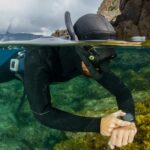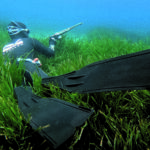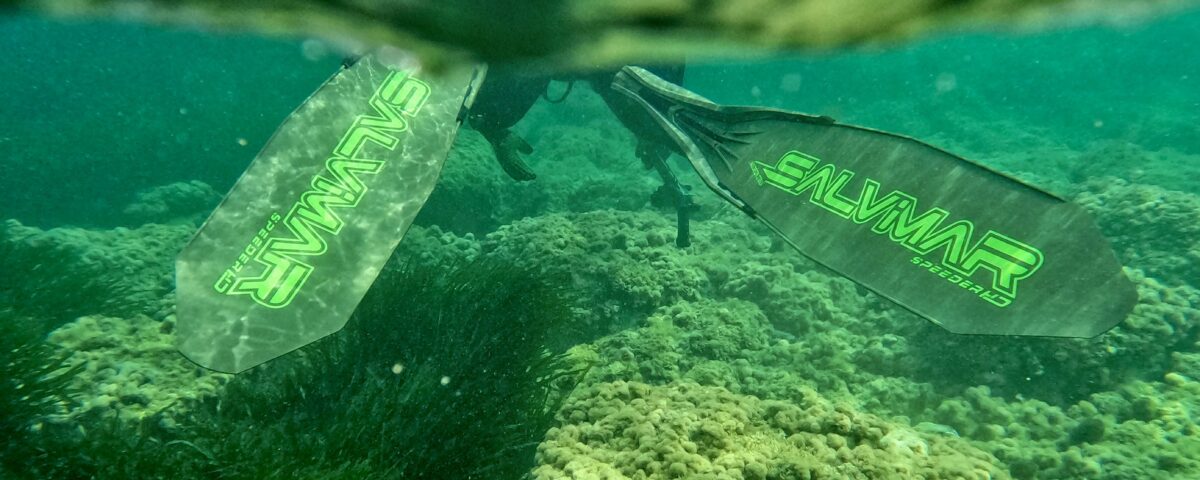SALVIMAR: Speeder HD

Garmin: Descent™ Mk3
22 July 2024
C4: Predator Fins
22 July 2024The new version of this interesting fin is characterized by a military green color. The blade is made of polypropylene with differentiated thickness and is paired with an innovative foot pocket, meticulously designed for unparalleled comfort!
Cristian Righetti
This month, we tested the Speeder HD (High Density) fins, a polypropylene model in military green, which is one of the many new products in the catalog. This fin has been the focus of engineering studies and innovations that I am curious to try "in the field." Upon arrival, I open the cardboard packaging; they are housed in a durable, hermetically sealed plastic bag, white/semi-transparent, with black Salvimar lettering. The first thing I notice, even "with the box closed," is the weight. In my mind, I had the (wrong) idea that being made of polymer, they wouldn't be feather-light, but I was wrong. They are really light!
At first glance, the eye catches the color, a uniform military green between the foot pocket and the blade, even though they are two separable bodies. On the upper side of the blade, the large Salvimar logo is printed in the classic acid green color, and below the main logo, in small letters, we find the "Made in Italy" mark and the model name, Speeder HD, also in acid green. The same applies to the other side.
The lines are attractive and modern, with a narrower design near the foot pocket (12 centimeters wide), widening to 21 centimeters near the center of the blade, and then narrowing again towards the end (19 centimeters). The tip is a sort of pyramid with a rounded cusp.
Getting into the details, the Speeder foot pockets are the result of extensive research on shape, structure, and materials; they were designed to outperform the previous generation fins and enhance wearing comfort. For these reasons, Salvimar developed a technology featuring underfoot rails to improve effort performance, ensuring maximum efficiency with every movement.
This innovation increases the fin's hydrodynamics. Now, the blade's attachment to the foot pocket is much narrower compared to most other models on the market, preventing water from simply rebounding off that area and not being channeled to the blade itself. This is well demonstrated in nature, as fish have a narrower caudal peduncle (tail stem) compared to the caudal fin, precisely to channel water particles to the caudal fin.
Salvimar realized, after careful engineering studies, that the same applies to apnea or fishing fins; the smaller the section at the base of the foot pocket, the more water particles are channeled towards the end of the blade, optimizing the stride. Additionally, the rails are complemented by rigid clips co-molded to the rubber, making the foot pocket and blade integral, optimizing energy transfer. During molding, a polypropylene insole is applied to the Speeder, providing rigidity while maintaining a soft and light upper (65 shore). Furthermore, it improves the adhesion between the blade and the foot pocket, along with the rigid clips of the rails (in glossy black).
The choice of materials allowed for weight and resistance optimization thanks to the differentiated thickness and a specially designed shape to lighten it without losing robustness. The differentiated thickness ensures that where the foot pocket receives more stress, the rubber thickness increases. The design of the front part was particularly refined and researched: to protect the toes, the front part of the upper is closed, ensuring comfort and efficiency. Additionally, a niche for the big toe was created inside the rail, ensuring perfect foot-knee alignment and, consequently, a stable kick.
This new design concept offers maximum comfort and a perfect fit, so much so that the Speeder HD can be worn without socks. During development, the Ligurian company paid particular attention to the characteristics of the foot pocket and blade, improving their interaction through the refinement of the attachment system, thus enhancing overall functionality.
The blade is secured not only by a snap system but also by two stainless steel screws positioned near the arch of both foot pockets. In this area, there are also two well-defined grooves to channel water towards the blade. The blade is molded in polypropylene, ensuring good thrust and excellent elastic return while minimizing effort. The blades form an angle of 29 degrees. For added thrust, they are made with differentiated thickness: the heel is 3.5 millimeters thick, while the tip is 1.8 millimeters. Water rails, about one centimeter long, are pre-molded and terminate near the tip's base. Speaking of numbers, the total length of the complete fin (with size 39/40 foot pocket) is 100 centimeters, and the weight is around 800 grams per fin. The Speeder HD is produced in four sizes: 39/40, 41/42, 43/44, and 45/46.
In the sea!
The first outing takes place on a gloomy day with increasing southwest wind. I know that, being early season, the water will be clear up to a maximum of 10, 12 meters. What better occasion to try the Speeder HD?
I prepare the equipment and place the fins in the Cyclops bag: they fit perfectly, so I don't have to put them in a special bag or carry them by hand. I reach an area north of Civitavecchia (where I live) and, after the usual dressing ritual, I am already on a rock, ready to get into the water; wearing Salvimar's Tactile green 3-millimeter socks, I move on to the fins, which I wear without any difficulty. The most positive thing is the sensation of having the foot completely wrapped without any constriction points. The real test, however, will be when I start kicking. I want to reach the edge to try to catch some predators; a swim of about 400, 500 meters awaits me.
I immediately notice that the Speeder HD pushes really hard, but to make the most of it, you need a trained leg. The foot pocket confirms its extreme softness, and the positive thing is that despite this, the thrust from the leg movement is transmitted to the blade without dispersion. I don't feel any skidding during the swim, thanks to the small water rails running parallel and external to the blade. The result: a fluid and continuous kick with little to no dispersion.
I reach the edge, and despite the nice swim, I don't feel any discomfort in my feet. In fact, such comfort I don't recall ever experiencing. However, to cover these distances, you need a trained leg. There is fish activity, and I can see it from the surface. The depth is about 12 meters. Last breath and down, 5 or 6 strokes, and I find myself almost at the bottom. I want to try an ambush, for which I need to consider the fin's length, slightly above average, but if the hiding spot is identified in advance, there are no problems. Nothing shows up, and I start the ascent. Pushing off the bottom is easy; just a "push" to immediately engage the water; I don't feel like I'm wearing a model with a polypropylene blade, the push-off is powerful, without voids or skidding!
Accustomed to very soft and high-performance carbon models for years, it doesn't take long to understand how to manage them in the water. Despite being made of technopolymer, I find that they push really well, provided you don't overdo the speed and power of the stroke. The kick needs to be careful and controlled; this way, we achieve maximum performance.
After three hours, I decide to return because there are no fish in sight! But before that, a few ambushes in the shallow water as the sea is increasing and a nice surge is forming near the shore. I want to make a short path that will end in an opening between the seagrass. Flip and down, I need to be careful with the fins. They are not exactly suitable for this type of technique due to their length, but given their lightness, they handle well, and I manage not to hit any rocks during the movement. Here I am well hidden just before the opening, waiting a few seconds, and suddenly a large leerfish appears. I hit it perfectly, the shaft piercing just behind the gill. It puts up a worthy fight of this species, but after a few minutes and several tens of meters of line unwound from the reel, I feel it tiring, so I decide to start retrieving it. Finally, I see it, here it is in all its majesty, I grab it with a swift move and immediately end its struggle! What a catch! For today, I am satisfied, so I decide to finish here and start jotting down my initial evaluations for the test.
The Speeder HD fins require a trained leg if you want to use them for shore fishing with long distances and medium depths, while for shorter outings at shallow depths, they are perfect for anyone! Their resistance and robustness, coupled with the softness and comfort of the foot pocket, make them suitable even for beginners who want a quality product at a reasonable price. And they are definitely good for the more experienced during winter to "train the legs" while waiting for the good season.
Thus, the initial impressions were positive, impressions that will be confirmed in the following fishing trips, some of which are set at slightly higher depths.
Scores
Design: 8.5 The goal was to create a "commercial" product with top features and cutting-edge technical solutions, all designed and manufactured at the Ligurian plant.
Materials: 8 A robust technopolymer that ensures good elastic return for the blade; the foot pocket has very soft rubber (65 shore) on the upper.
Comfort: 9 The Speeder foot pocket is incredible. The foot is perfectly wrapped, and the niche for the big toe minimizes, or rather eliminates, the annoying toe cramps we are used to. In summer, socks can even be avoided.
Performance: 7 Best performance in medium depths, when the right balance between stroke and force is found.
Design: 9 The innovative foot pocket design and the differentiated thickness blade are significant advantages. Hard to ask for more.
Value for money: 8 The Speeder HD costs around 110 euros. Definitely well-spent money.



